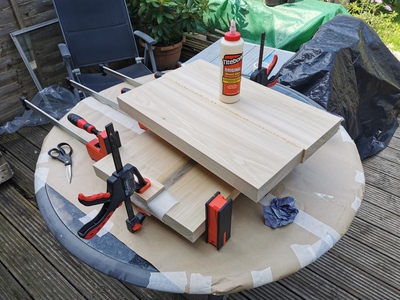Great demonstration today of how hard it is to prepare wood using hand tools. I’d love a drum sander but don’t have the space, so if your limited like me or don’t even have power this is what I use.
First photo is a Lie Neilsen scraper plane with the blade just forward of vertical, bevel facing back. Blade is hard to sharpen and needs a diamond stone. Other planes are available but I went for more expensive brass as my work area doesn’t have heating and rust is a problem. For reference it’s on A4 size paper.
Second photo is a tooth blade which Mark talked about. This one is about 2/12 inches or 60cm long and I’ve never seen one in a large size. I use it for smoothing out gouge marks on the inside of flame maple violin backs. A quick way to reduce the thickness on a smooth flat surface is to alternate between tooth and smooth blades leaving enough for final sanding.
However I’m starting to think that buying wood ready prepared is the best option.
Some people call me a tool, others are less complimentary. Tools being useful things.
@markbailey I feel I need to add something to this topic. This is an example of the problems I ran into when jointing some billets together to make a body blank for an electric guitar. This wood is Poplar that I got online somewhere. I thought everything was going well until........ 😖😂 Doh
I still haven’t fixed it fully and even the other one wasn’t as good as I thought, it took me ages to get it flat as I used hand tools (I don’t have thousands to spend on the machinery).
Yes I bought some cheaper wood, but the amount of work I had to do to get it to a usable state for guitar building was exhausting. If you are not an experienced woodworker with all the machinery, it’s very difficult to get everything flat and straight. When you buy stuff online or even from your local wood store, it’s not always as flat as they say it is. It’s such a pain to do all of this, it’s much easier to pay that bit extra to have it made right, ready to work on for guitar building. Even if you paid a woodworker to stick it all though the machines he/she has, are they going to take the time to get it right for guitar building or is it better to get the experienced guitar maker to prep it all for you? I now know from experience and the video below just shows how ridiculous things can get but it doesn’t show the amount of work it took to rectify it.
It is absolutely essential that you have properly prepared blanks for guitar building. If you don’t, it has a knock on effect and throws everything out as you go along. If you are following Mark’s video courses and something looks out on your project as you are building it, and if your blanks were not straight and flat to start with, well 👎
Save yourself a lot of hurt and spend the extra few quid (£) to buy all the stuff from Mark, especially if it is your first time building a guitar. You can always try making your own blanks when you have gained a bit more experience, like I did. 🤣🤣🤣🤣
Look at these pictures, all looks fine and well.
Now watch the short video of when it was taken out of the clamps. 🤣🤣🤣🤣
Make guitars, not war 🌍✌️🎸
I need to have a rethink 🤣🤣🤣🤣
Make guitars, not war 🌍✌️🎸
Always check that your jointed faces are 90deg to the top & back of the pieces!
Yup, I’ve done the same myself, though that’s when I’d made my own blanks, so possibly only one person at fault ....
Online guitar making courses – guitarmaking.co.uk
Always check that your jointed faces are 90deg to the top & back of the pieces!
It doesn’t have to be - if the fence is off and you put the two pieces back to front (if that makes sense) it should still work..
I have too many guitars...said no one in the world..ever!
Dude, nice clamps! Are they the real thing?
@mattbeels Thanks, they were on offer a while ago and I couldn’t resist. They were about £80 for 4 or something like that.
Make guitars, not war 🌍✌️🎸
I feel your pain with the bowed body blank, I’ve been there a few times in the early days. I always check now by putting one half in a vice with the glue edge facing up. Sit the second half on top and see if it’s vertical and stays in place without falling over. Then shine a light through. Obviously checking with a square is a another way but planing is usually done after joining so there’s no guarantee that you have a flat surface to work from.
Some people call me a tool, others are less complimentary. Tools being useful things.
I do this every time just to make sure...
When you see that, it's just so brilliant and obvious at the same time!
Thanks @deej
Even if you've set your fence to be square, there's still the possibility of it being fractionally off. Plane this way, and all's good.
It's going to take my head a little while to work out how to achieve the grain pattern join that I want, but worth it!
Online guitar making courses – guitarmaking.co.uk









